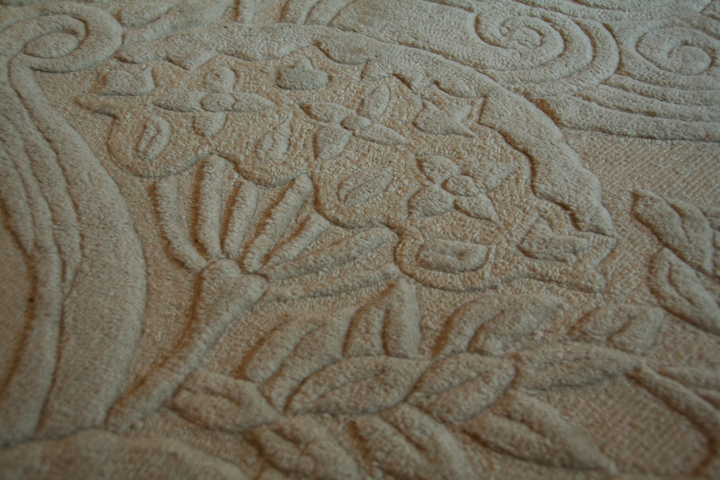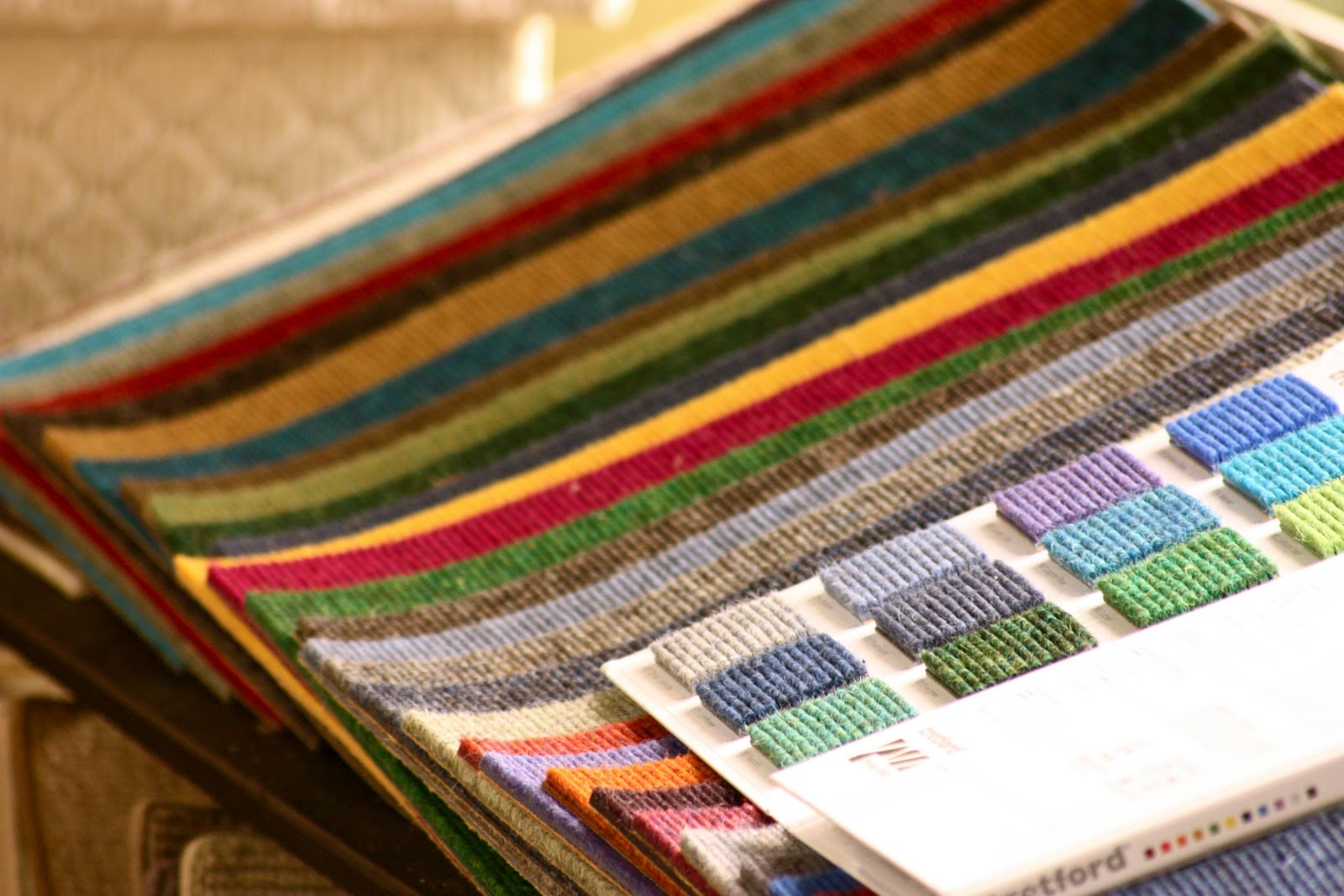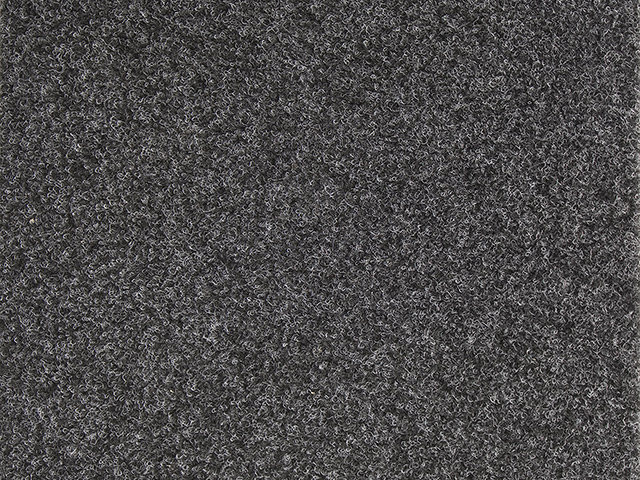Tufted Carpets

These are manufactured using a broadloom, usually in 12' widths (but any width more than 27" qualifies as broadloom). Face yarns are stitched or tufted into the backing.
The Components
Primary Backing - Either jute or polypropylene
Face Yarn - May be dyed or un-dyed. Un-dyed face yarns tufted into the primary backing are called "griege goods".
Latex Adhesive Layer
Secondary Backing
Construction
The primary backing (usually jute or polypropylene) is run through the tufting machine. Jute backing will tend to shrink more than polypropylene but it gives better dimensional stability (the ability of carpet to retain its size and shape) and is less likely to stretch under heavy traffic.
The speed at which the backing advances through the machine determines the distance between tufts along the length of the carpet, or the "pitch" (tufts per inch). The distance between the needles determines the distance between tufts along the width of the carpet, or the "gauge". A 1/10 gauge means the needles are 1/10" apart.
Creation of different pile configurations and heights is created by adjusting the looper to pull the tuft to a longer or shorter height. Different heights can be achieved on the same carpet resulting in a sculptured loop pile.
Cut pile is produced by including a cutting edge at the back of the looper that cuts the tuft as it passes on to the next tuft.
The next step is the application of a latex adhesive that serves several purposes.
1) It holds the tufts in place, keeping them from being pulled out or raveled.
2) It gives a stability to the finished product.
3) It holds the primary and secondary backing together.
Next the secondary backing is applied over the latex adhesive. This backing adds to the weight, durability and dimensional stability. It will be either jute or polypropylene.
The final steps in making a tufted carpet are curing (baking the carpet to cure the latex) and finishing (shearing, vacuuming and inspection).
Fusion Bonded Carpets

Components
- Backing material (this can be either natural or synthetic, most often synthetic.)
- Thermoplastic Adhesive (these are similar in chemical composition to the synthetic fibers itself and it is very strong, chemical resistant and durable.)
- Face Yarns (these are almost always synthetic.)
- Single End Implantation (involves the application of a latex or thermoplastic adhesive to either a natural or synthetic carpet backing, which is then smoothed to a uniform thickness with a doctor blade. Yarn implantation then takes place whereas the yarn end is adhesive is cured. The carpet is then cooled and prepared for finishing procedures.
- Multifold Implantation (involves two backing materials as opposed to the single one used in single end implantation. Adhesive is applied and smoothed out on both backings. Curing is accomplished in a curing oven during which the adhesive is solidified, and the yarns are permanently affixed to the primary backing. Then the two carpets simultaneously-made carpets are separated by precise cutting of the yarns which, in the course of separation, become the cut-pile face yarns for the two separate carpets.
Economic Advantages
- Bonding eliminates the need for a secondary backing, thus eliminating a costly step.
- Less face yarn is required since none of it is hidden below the backing surface. The fact that untwisted yarns may be used eliminates another step in manufacturing,
Durability Advantages
- There is no chance of standard delamination experienced in tufted carpets since there is no secondary backing.
- There is less opportunity for tuft loss or raveling since each yarn is individually bonded to the adhesive.
- There is much less chance of shrinkage since the backing is usually synthetic and the thermoplastic adhesive produces a moisture barrier.
Needle Punched Carpets

Needle punching involves a process in which short staple fibers are punched with barbed needles into a spun, synthetic scrim and thus intertwined to the extent that a thin mat of fiber is formed. Needle punched carpet is usually made of all-synthetic materials containing solution-dyed olefin fiber. This makes the carpet quite moisture resistant, fast drying, sun resistant and chemically inert. For these reasons, needle punched carpet is ideally suited for locker rooms, pool decks, patios, outdoor matting and generally anywhere else sunlight and moisture are found. It is inexpensive and easily replaced when worn (the simplicity of construction and minimal thickness do not make it very long-lasting.)
Construction Elements
- Backing material (usually made of spun polypropylene.)
- Olefin staple fibers (formed in a dense web.)
- Latex Adhesive
Manufacturing Procedure
1) A dense fiber web is formed similar to that which is removed from the carding machine in the yarn making process. A very thin nylon scrim is often included to provide strength, elasticity and dimensional stability.
2) The backing material (which is usually spun polypropylene) is fed into position under the conveyor, which places the fiber web on top.
3) The backing and web move into position under a needle bar containing several rows of barbed needles. Aligned beneath the needle bar is a needle plate that contains holes that correspond to the barbed needles in the bar above. The needles now punch through the backing material, and the barbs carry some of the fiber web all the way through the backing. This results in excellent entanglement of the fiber web with the fibers comprising the backing material. The needles are extracted; the backing moves forward and the process is repeated in the same manner.
4) Lastly, a thin coat of latex adhesive is sprayed on the back side of the carpet, and after curing, the needle punched carpet is complete.
